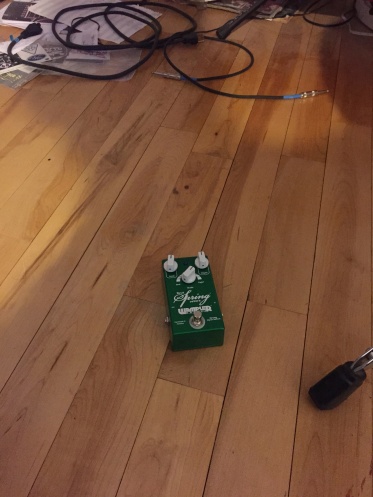15. V 2019
And now for something completely different: Ronin guitars
Everything is ruled by lightning (Heraclitus)
How does one come up with an original take on tradition without putting it upside down? This usually presents a delicate task due to its inherent ambiguity. Originality consists of returning to the origin; it defines the direction of a journey. It is not so much the creation of the new, as it is putting the familiar into new relations. The makers of Ronin guitars seem to have found a way to accomplish this mission: Their instruments remain deeply rooted in the tradition, but with an altogether different take on it.
The big bang of Ronin’s guitars can be traced back to an accident of nature some 800 years ago — a redwood tree in northern California struck by lightning; its remains would be discovered (accidentally) many centuries later on the Reed family’s land. The reserves of that reclaimed redwood have been the life supply of Ronin guitars. Aged wood is a must for good sound. With age, wood changes its density, it becomes lighter and more resonant. Vintage guitars from the 1950s and 1960s owe their superior tone largely to the selection and age of their wood. Usually it takes 50-100 years for the wood to achieve its optimal resonance properties. Clearly, 800 years is over the top.
Redwood is notoriously difficult to work with, but the rewards are multiple. However, the real problem of using redwood as production material is its supply. The trees are protected and supply is limited to reclaimed reserves only. Any project that involves redwood is, therefore, a finite endeavor. Once the reserves are exhausted, the guitar production is over. For Ronin guitars, that moment came in 2018. The last orders were made in mid-December.

It took one hour of playing and two phone calls with John Reed to pull the trigger before the December deadline. Four months later: Morningstar and Coyote.
Various guitars have become synonymous with particular musical genres. Ronin guitars, however, sound like none of them. No matter which model you pick, it is not a Strat, or Tele, or Gibson, it is definitely its own thing. Never seen before, yet strangely familiar and comfortable. They don’t fill the space in between, but define their own territory. They transcend genre boundaries and stand as the instruments around which new styles are to be created. Their conceptual simplicity is apparent at first encounter: The superb tonal action of the magical wood is perfectly transformed by the unique pickups, bound together with impeccable craftsmanship. The best vintage guitars are resonant, but this is next level. The sustain is the result of the synergy between the redwood and the voicing of the Foilbucker pickups.
The pickups are the result of Ronin’s collaboration with David Torn, entirely custom-made and designed from the ground up to capture the tone character of vintage Teisco and DeArmond “gold foils”, only now in a humbucking format. Until relatively recently, gold foils have been a part of eccentric exotica used by sliders and retro aficionados. They have experienced a rapid revival in last few years with their superior performance attracting the attention of a wider audience. Nowadays, a handful of manufactures, like Lollard, Mojotone, and Klein, are manufacturing and marketing their own versions.
Compared to traditional pickups, Ronin’s Foilbuckers combine the best of both worlds, full range without exaggerated mids, great clarity and spark, but with a thickness that you find in the best of P-90’s together with the edginess of the original gold foils. They give the guitar an exceptional touch sensitivity with the body and bottom of humbuckers without ever being muddy. They are at home with jazz and country moods as well as blues, rock and grunge. There is chime galore, crispness, clarity and muscle in the same package. The wood/pickup combination covers an unusually wide terrain, mostly of its own, but when they overstep the territory of the other greats, they set new standards of tone and performance there. While one encounters occasional shades of Fender, Gibson p-90’s, or even Rickenbacker, Gretsch is probably the top contender for a distant cousin.
Overdrive (either tube or pedals) takes them to entirely new places. When overdriven, most pickups’ tone tends to get sugary on the verge of losing its integrity. They sound claustrophobic — there is too much entropy — as if you jammed too many people in a small room, everybody stepping on somebody’s toes. Chords sound “overcrowded”, almost out of tune — one instinctively reaches for tuners to correct intonation. None of that is present with Ronins. The “room” is never too small to accommodate everyone, no matter how big the “crowd”. The original tonal character is preserved; it never falls apart, but becomes a higher-octane version of the clean tone.
Ronins really stand out when played against the background. Without needing to crank up the volume, they cut through the mix with incredible ease. Most guitars, run of the mill or vintage, just drown. The tone controls are meaningful — something one can really work with, never excessive to squash or deform the tone — delicate, yet substantial at the same time, as if each dial down defines its own territory and purpose. The necks are an entirely different project. Beautiful to look at and comfortable in you hand, they are made from roasted maple, their acoustic, mechanical properties are fine tuned to optimize the fit with the body/pickup combination.
The designs are an eloquent summary of what one hears — a visual translation of their acoustic performance. Impeccable aesthetics, from varnish to frets, hardware and various appointments, with a nod to tradition, but on their own ground; very Teutonic, never in your face, yet prominent.
However, the most striking thing about Ronins, what sets them apart from the others, is their character, which they have in abundance. Most great vintage guitars owe their reputation to their idiosyncrasies and imperfections. That is what gives each of them its character. They do something great and then they have their flaws, which forces players to go to unexpected places and do things they otherwise wouldn’t. Eradicating these flaws, designing a flawless guitar, threatens its character. This is where Ronin makes the most significant departure from the rest. Majority of other boutique guitar makers take a shot at classic vintage models and look to eliminate their limitations and shortcomings by creating a perfect version of a, say, Tele or Strat. They never leave the traditional framework, but work their ways to bring back the craftsmanship of the old days and take out the short cuts of the assembly line production. Ronin guitars approach perfection in many aspects, but in a different way. Their natural habitat resides in an entirely different hyperplane. Their journey has had an unorthodox trajectory along which they made occasional stops on the conventional territory just to pay tribute to the tradition, only to move on and resume their course after that. There is an unmistakable feeling that perfection for its own sake had never been their explicit goal, but a consequence of a different journey. At the end it was all about tone and character.
29. VIII 2016
ThroBak Humbacker clone PAF pickups
There is a booming cottage industry of PAF clones. ThroBaks are among the best known (for my ears, the best) on the market. They ain’t cheap ($540), but well worth it. Capable of turning pretty much every (decent) guitar into a singing vintage Gibson, or very close to it. Standard pickups of any making just don’t come anywhere close to these.
PG-102 MXV PAF are medium output with following specks: Neck 8.2K Bridge 8.6K, and long A5 magnets. They are wound with the same output specifications as the vintage PAF pickups in the original 1959 Les Paul played by Peter Green and utilizing oriented vintage spec. With the neck magnet flipped for middle position out of phase tones, these PAF humbucker pickup clones give tonal colors made legendary by Peter Green. A stunning variety of tones can be had from simple volume, tone and selector switch adjustment. With coils wound on the ThroBak vintage Leesona 102 winder the PG-102 vintage PAF humbucker pickup clones encapsulates the vintage PAF pickup pickup at its zenith.
Jon Gundry, the owner, was super nice/helpful/patient during our discussion and selection of the specs.
11. IV 2016
Keeley Katana Clean Boost
Keeley’s could easily be the best pedals on the market. All hand made, super nice and helpful stuff. Katana’s my favorite. All one really needs. The pull up mode is absolutely insane.
Just in: Spring Reverb pedal by Wampler. As good as reverbs get (much better than racks). This is a standard accessory used by the Nashville crowd.

